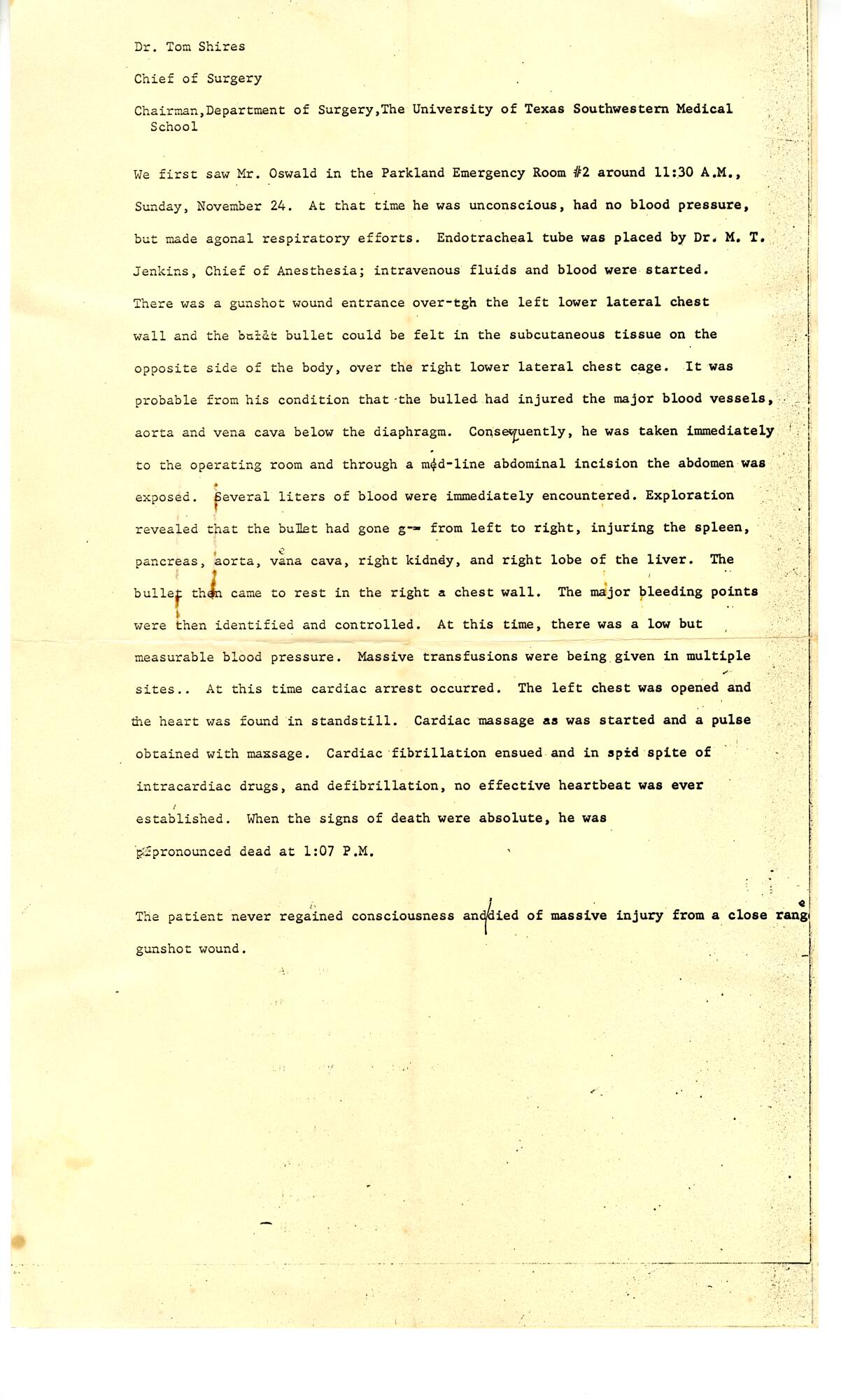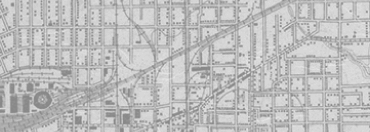


Back
Photocopy of press release by Dr. Tom Shires regarding Oswald's Treatment
Photocopy of Dr. George Thomas "Tom" Shires' public statement regarding Lee Harvey Oswald's treatment and death at Parkland Hospital. Dr. Shires was the Chief of Surgery and Chairman for the Department of Surgery at The University of Texas Southwestern Medical School.The text of the letter (with typos intact) reads:"Dr. Tom Shires"Chief of Surgery"Chairman, Department of Surgery, The University of Texas Southwestern Medical School"We first saw Mr. Oswald in the Parkland Emergency Room #2 11:30 A.M., Sunday, November 24. At that time he was unconscious, had no blood pressure, but made agonal respiratory efforts. Endotracheal tube was placed by Dr. M. T. Jenkins, Chief of Anesthesia; intravenous fluids and blood were started. There was a gunshot wound entrance over-tgh the left lower lateral chest wall and the bullet could be felt in the subcutaneous tissue on the opposite side of the body, over the right lower lateral chest cage. It was probable from his condition that the bulled had injuredthe major blood vessels, aorta and vena cava below the diaphragm. Consequently, he was taken immediately to the operating room and through a mid-line abdominal incision the abdomen was exposed. Several liters of blood were immediately encountered. Exploration revealed that the bullet had gone g-- from left to right, injuring the spleen, pancreas, aorta, vena cava, right kidney, and right lobe of the liver. The bullet then came to rest in the right a chest wall. The major bleeding points were then identified and controlled. At this time, there was a low but measureable blood pressure. Massive transfusions were being given in multiple sites.. At this time cardiac arrest occured. The left chest was opened and the heart was found in a standstill. Cardiac massage as was started and a pulse obtained with massage. Cardiac fibrilliation ensureds and in spid spite of intracardiac drugs, and defibrillation, no effective heartbeat was ever established. When the signs of death were absolute, he was pronounced dead at 1:07 P.M."The patient never regained consciousness and died of massive injury from a close range gunshot wound."
Photocopy of press release by Dr. Tom Shires regarding Oswald's Treatment
11/24/1963
Paper
14 x 8 1/2 in. (35.6 x 21.6 cm)
Peter N. Geilich Collection/The Sixth Floor Museum at Dealey Plaza
2007.015.0003
Donor Peter N. Geilich was an administrator at Woodlawn and Parkland Memorial Hospitals in Dallas from 1962 to 1969. Following the assassination, he helped coordinate media relations and arrangements with the Connally and Oswald families. He later spent time with Jack Ruby during his brief stay at Parkland in late 1966. Geilich recorded oral histories with the Museum in 2007 and 2009 as well as a Living History education program in 2009. -- Stephen Fagin, Curator

Photocopy of press release by Dr. Tom Shires regarding Oswald's Treatment
Photocopy of Dr. George Thomas "Tom" Shires' public statement regarding Lee Harvey Oswald's treatment and death at Parkland Hospital. Dr. Shires was the Chief of Surgery and Chairman for the Department of Surgery at The University of Texas Southwestern Medical School.The text of the letter (with typos intact) reads:"Dr. Tom Shires"Chief of Surgery"Chairman, Department of Surgery, The University of Texas Southwestern Medical School"We first saw Mr. Oswald in the Parkland Emergency Room #2 11:30 A.M., Sunday, November 24. At that time he was unconscious, had no blood pressure, but made agonal respiratory efforts. Endotracheal tube was placed by Dr. M. T. Jenkins, Chief of Anesthesia; intravenous fluids and blood were started. There was a gunshot wound entrance over-tgh the left lower lateral chest wall and the bullet could be felt in the subcutaneous tissue on the opposite side of the body, over the right lower lateral chest cage. It was probable from his condition that the bulled had injuredthe major blood vessels, aorta and vena cava below the diaphragm. Consequently, he was taken immediately to the operating room and through a mid-line abdominal incision the abdomen was exposed. Several liters of blood were immediately encountered. Exploration revealed that the bullet had gone g-- from left to right, injuring the spleen, pancreas, aorta, vena cava, right kidney, and right lobe of the liver. The bullet then came to rest in the right a chest wall. The major bleeding points were then identified and controlled. At this time, there was a low but measureable blood pressure. Massive transfusions were being given in multiple sites.. At this time cardiac arrest occured. The left chest was opened and the heart was found in a standstill. Cardiac massage as was started and a pulse obtained with massage. Cardiac fibrilliation ensureds and in spid spite of intracardiac drugs, and defibrillation, no effective heartbeat was ever established. When the signs of death were absolute, he was pronounced dead at 1:07 P.M."The patient never regained consciousness and died of massive injury from a close range gunshot wound."
Photocopy of press release by Dr. Tom Shires regarding Oswald's Treatment
11/24/1963
Press release
Oswald, Lee Harvey
Shires, George Thomas "Tom"
Geilich, Peter N.
Parkland Hospital
Dallas
Paper
14 x 8 1/2 in. (35.6 x 21.6 cm)
Peter N. Geilich Collection/The Sixth Floor Museum at Dealey Plaza
2007.015.0003
Donor Peter N. Geilich was an administrator at Woodlawn and Parkland Memorial Hospitals in Dallas from 1962 to 1969. Following the assassination, he helped coordinate media relations and arrangements with the Connally and Oswald families. He later spent time with Jack Ruby during his brief stay at Parkland in late 1966. Geilich recorded oral histories with the Museum in 2007 and 2009 as well as a Living History education program in 2009. -- Stephen Fagin, Curator









